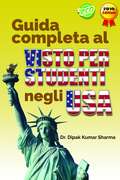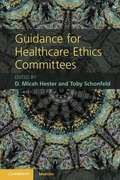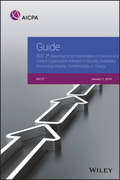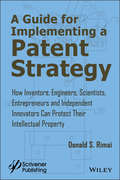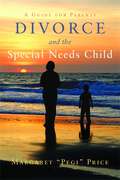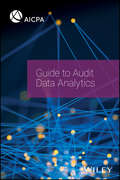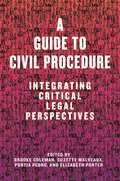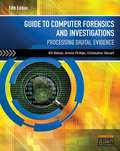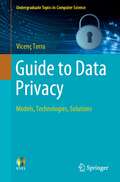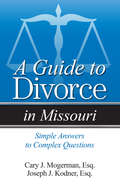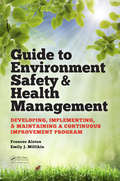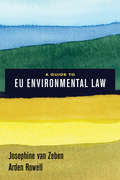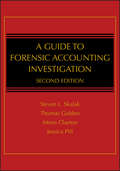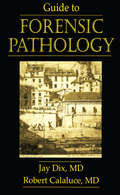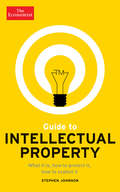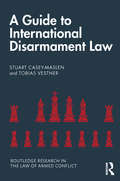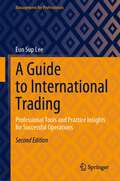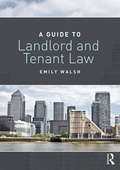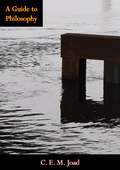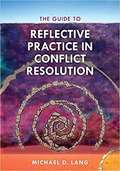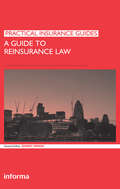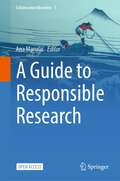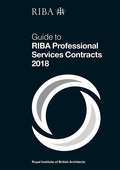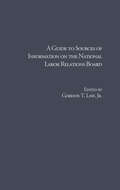- Table View
- List View
Guida completa al VISTO PER STUDENTI negli USA
by Dr Dipak Kumar SharmaQuesto è "il libro di tutti i libri" per quanto riguarda il visto americano. Contiene tutte le informazioni necessarie dalla raccolta dei documenti per richiedere il visto all'ottenimento della cittadinanza. È utile sia a chi sta pensando di studiare negli USA sia a chi si trova già lì e ha bisogno di chiarimenti su alcuni punti. La sua stesura sotto forma di domande e risposte fa luce su qualsiasi passo della procedura di domanda, il viaggio, l'università, la vita, il lavoro, l'uscita e la cittadinanza. Il libro è disponibile anche in inglese, spagnolo, portoghese e cinese.
Guidance for Healthcare Ethics Committees
by Toby Schonfeld D. Micah HesterEvery accredited American hospital is required to have a mechanism for handling ethical concerns; most hospitals satisfy this requirement by constituting an institutional healthcare ethics committee (HEC), a pattern which is repeated in most western countries. This text provides definitive, comprehensive guidance for members of healthcare ethics committees who find themselves confronted with ethically challenging situations. Each chapter includes learning objectives, clinical case studies and questions to stimulate discussion among committee members. Particular emphasis is given to consultation, as this often presents the greatest challenges to committee members. Each chapter stands alone as a teaching module, as well as forming part of a comprehensive volume. Written and edited by nationally and internationally recognized experts in bioethics, this is essential reading for every member of a healthcare ethics committee.
Guide: SOC 2 Reporting on an Examination of Controls at a Service Organization Relevant to Security, Availability, Processing Integrity, Confidentiality, or Privacy (AICPA)
by AicpaUpdated as of January 1, 2018, this guide includes relevant guidance contained in applicable standards and other technical sources. It explains the relationship between a service organization and its user entities, provides examples of service organizations, describes the description criteria to be used to prepare the description of the service organization’s system, identifies the trust services criteria as the criteria to be used to evaluate the design and operating effectiveness of controls, explains the difference between a type 1 and type 2 SOC 2 report, and provides illustrative reports for CPAs engaged to examine and report on system and organization controls at a service organization. It also describes the matters to be considered and procedures to be performed by the service auditor in planning, performing, and reporting on SOC 2 and SOC 3 engagements.New to this edition are: Updated for SSAE No. 18 (clarified attestation standards), this guide has been fully conformed to reflect lessons learned in practice Contains insight from expert authors on the SOC 2 working group composed of CPAs who perform SOC 2 and SOC 3 engagements Includes illustrative report paragraphs describing the matter that gave rise to the report modification for a large variety of situations Includes a new appendix for performing and reporting on a SOC 2 examination in accordance with International Standards on Assurance Engagements (ISAEs) or in accordance with both the AICPA’s attestation standards and the ISAEs
A Guide for Implementing a Patent Strategy: How Inventors, Engineers, Scientists, Entrepreneurs, and Independent Innovators Can Protect Their Intellectual Property
by Donald S. RimaiThis book is aimed at the innovators who drive the advances from which we all benefit. This includes scientists, engineers, technicians, managers, and entrepreneurs who want to financially benefit from their innovations. The book describes how to build patent portfolios that will properly protect your technology and be of financial benefit. The tools that innovators need to have to generate patents are presented in detail.
A Guide for Parents Divorce and the Special Needs Child
by Margaret Pegi" PriceGoing through a divorce is always tough, but when a child with special needs is involved it can be especially challenging. This book takes a clear and comprehensive look at every aspect of the legal divorce process, and addresses all of the legal issues that divorcing parents of children with special needs face. The author guides parents through the initial hurdles of choosing the right lawyer for their case, and explains exactly how to work with them to achieve the best possible outcome for all concerned. From agreeing upon child custody arrangements that meet the particular needs of the child, to making provision for child support payments, gathering together the documentation needed to prove a case, and dealing with financial issues such as debts and property distribution, no aspect of divorce is left uncovered. A set of checklists is included to ensure that parents consider everything they need to, and the book concludes with a useful list of further resources. Written by an experienced family lawyer who went through her own divorce when her son, who has autism, was six, this book offers much-needed guidance to divorcing parents of children with a variety of special needs.
Guide to Audit Data Analytics
by AicpaDesigned to facilitate the use of audit data analytics (ADAs) in the financial statement audit, this title was developed by leading experts across the profession and academia. The guide defines audit data analytics as “the science and art of discovering and analyzing patterns, identifying anomalies, and extracting other useful information in data underlying or related to the subject matter of an audit through analysis, modeling, and visualization for planning or performing the audit.” Simply put, ADAs can be used to perform a variety of procedures to gather audit evidence. Each chapter focuses on an audit area and includes step-by-step guidance illustrating how ADAs can be used throughout the financial statement audit. Suggested considerations for assessing the reliability of data are also included in a separate appendix.
A Guide to Civil Procedure: Integrating Critical Legal Perspectives
by Brooke Coleman, et al.Shines a light on the ways in which civil procedure may privilege—or silence—voices in our justice systemIn today’s increasingly hostile political and cultural climate, law schools throughout the country are urgently seeking effective tools to address embedded inequality in the United States legal system. A Guide to Civil Procedure aims to serve as one such tool by centering questions of systemic injustice in the teaching, learning, and practice of civil procedure.Featuring an outstanding group of diverse scholars, the contributors illustrate how law school curriculums often ignore issues such as race, gender, disability, class, immigration status, and sexual orientation. Too often, students view the #MeToo movement, Black Lives Matter, immigration/citizenship controversy, or LGBTQ+ issues as mere footnotes to their legal education, often leading to the marginalization of many students and the production of graduates that do not view issues of systemic injustice as central to their profession.A Guide to Civil Procedure reveals how procedure is, and always has been, a central pressure point in the struggle to eradicate structural inequality and oppression through the courts. This book will give students and scholars alike a more complex view of their roles as attorneys, sharpen their litigation skills, and provide a stronger sense of community and purpose in the law school classroom.
Guide to Computer Forensics and Investigations: Processing Digital Evidence
by Bill Nelson Amelia Phillips Christopher SteuartUpdated with the latest advances from the field, GUIDE TO COMPUTER FORENSICS AND INVESTIGATIONS, Fifth Edition combines all-encompassing topic coverage, authoritative information from seasoned experts, and real-world applications to deliver the most comprehensive forensics resource available. This proven author team's wide ranging areas of expertise mirror the breadth of coverage provided in the book, which focuses on techniques and practices for gathering and analyzing evidence used to solve crimes involving computers. While other books offer more of an overview of the field, this hands-on learning text provides clear instruction on the tools and techniques of the trade, introducing readers to every step of the computer forensics investigation-from lab set-up to testifying in court. It also details step-by-step guidance on how to use current forensics software and provides free demo downloads. Appropriate for learners new to the field, it is also an excellent refresher and technology update for professionals in law enforcement, investigations, or computer security.
Guide To Computer Forensics And Investigations: Processing Digital Evidence (Fifth Edition)
by Bill Nelson Amelia Phillips Christopher SteuartUpdated with the latest advances from the field, GUIDE TO COMPUTER FORENSICS AND INVESTIGATIONS, Fifth Edition combines all-encompassing topic coverage and authoritative information from seasoned experts to deliver the most comprehensive forensics resource available. This proven author team’s wide ranging areas of expertise mirror the breadth of coverage provided in the book, which focuses on techniques and practices for gathering and analyzing evidence used to solve crimes involving computers. Providing clear instruction on the tools and techniques of the trade, it introduces readers to every step of the computer forensics investigation-from lab set-up to testifying in court. It also details step-by-step guidance on how to use current forensics software. Appropriate for learners new to the field, it is also an excellent refresher and technology update for professionals in law enforcement, investigations, or computer security.
Guide to Data Privacy: Models, Technologies, Solutions (Undergraduate Topics in Computer Science)
by Vicenç TorraData privacy technologies are essential for implementing information systems with privacy by design.Privacy technologies clearly are needed for ensuring that data does not lead to disclosure, but also that statistics or even data-driven machine learning models do not lead to disclosure. For example, can a deep-learning model be attacked to discover that sensitive data has been used for its training? This accessible textbook presents privacy models, computational definitions of privacy, and methods to implement them. Additionally, the book explains and gives plentiful examples of how to implement—among other models—differential privacy, k-anonymity, and secure multiparty computation.Topics and features:Provides integrated presentation of data privacy (including tools from statistical disclosure control, privacy-preserving data mining, and privacy for communications)Discusses privacy requirements and tools for different types of scenarios, including privacy for data, for computations, and for usersOffers characterization of privacy models, comparing their differences, advantages, and disadvantagesDescribes some of the most relevant algorithms to implement privacy modelsIncludes examples of data protection mechanismsThis unique textbook/guide contains numerous examples and succinctly and comprehensively gathers the relevant information. As such, it will be eminently suitable for undergraduate and graduate students interested in data privacy, as well as professionals wanting a concise overview.Vicenç Torra is Professor with the Department of Computing Science at Umeå University, Umeå, Sweden.
A Guide to Divorce in Missouri: Simple Answers to Complex Questions (Divorce In)
by Cary J. Mogerman Joseph J KodnerProviding accurate and objective information to help make the right decisions during a divorce in Missouri, this guide provides answers to 360 queries such as What is the mediation process in Missouri and is it required? How quickly can one get a divorce? Who decides who gets the cars, the pets, and the house? What actions might influence child custody? How are bills divided and paid during the divorce? How much will a divorce cost? and Will a spouse have to pay some or all attorney fees? Structured in a question-and-answer format, this divorce handbook provides clear and concise responses to help build confidence and give the peace of mind needed to meet the challenges of a divorce proceeding.
Guide to Environment Safety and Health Management: Developing, Implementing, and Maintaining a Continuous Improvement Program (Systems Innovation Book Series)
by Frances Alston Emily J. MillikinDevelopment and execution of a successful ES&H program in today's profit-driven business climate is challenging and complex. The techniques outlined in this book provide guidance and aid in understanding the challenges that must be addressed by ES&H management and professionals. This book covers the primary areas of ES&H and key elements that should be considered in developing, managing, and implementing an effective, compliant and cost effective program. It to fulfills the need that exists in the workplace for guidance from a practical experience view point.
A Guide to EU Environmental Law
by Josephine van Zeben Arden RowellWritten by two internationally respected scholars, this unique primer distills European Union environmental law and policy into a practical guide for a nonlegal audience, as well as for lawyers trained in other jurisdictions. The first part explains the basics of the European legal system, including key actors, types of laws, and regulatory instruments. The second part describes the EU’s overarching legal strategies for environmental management and delves into how the EU addresses the specific environmental issues of pollution, ecosystem management, and climate change. Chapters include summaries of key concepts and discussion questions, as well as informative "spotlights" offering brief overviews of topics. With a highly accessible structure and useful illustrative features, A Guide to EU Environmental Law provides a long-overdue synthetic resource on EU environmental law for students and for anyone working in environmental policy or environmental science.
A Guide to Forensic Accounting Investigation
by Thomas W. Golden Steven L. Skalak Mona M. Clayton Jessica S. PillRecent catastrophic business failures have caused some to rethink the value of the audit, with many demanding that auditors take more responsibility for fraud detection. This book provides forensic accounting specialists?experts in uncovering fraud?with new coverage on the latest PCAOB Auditing Standards, the Foreign Corrupt Practices Act, options fraud, as well as fraud in China and its implications. Auditors are equipped with the necessary practical aids, case examples, and skills for identifying situations that call for extended fraud detection procedures.
Guide to Forensic Pathology
by Jay DixGuide to Forensic Pathology provides a concise overview of forensic pathology to those who wish to know the basics but lack formal forensic training. Both fascinating and practical, this book explains everything from who the experts are in death investigation and what their roles are to how effective testimonies are presented in court. The importance of forensic DNA testing is emphasized with a separate section in this timely reference guide.
Guide to Intellectual Property: What it is, How to Protect it, How to Exploit it (Economist Books)
by Stephen JohnsonIntellectual Property (IP) is often a company’s single most valuable asset. And yet IP is hard to value, widely misunderstood and frequently under-exploited. IP accounts for an estimated $5trn of GDP in the US alone. It covers patents, trademarks, domain names, copyrights, designs and trade secrets. Unsurprisingly, companies zealously guard their own ideas and challenge the IP of others. Damages arising from infringements have fostered a sizeable claims industry. But IP law is complex, and the business, financial and legal issues around it are difficult to navigate. Court decisions and interpretation of IP laws can be unpredictable, and can dramatically change the fortunes of businesses that rely on their IP - as demonstrated in the pharmaceutical industry’s battle with generic drugs. This comprehensive guide to intellectual property will help companies, investors, and creative thinkers understand the scope and nature of IP issues, pose the right questions to their advisers and maximize the value from this crucial intangible asset.
A Guide to International Disarmament Law (Routledge Research in the Law of Armed Conflict)
by Stuart Casey-Maslen Tobias VestnerDisarmament is integral to the safeguarding and promotion of security, development, and human rights. Hundreds of millions of dollars are spent each year on disarmament operations, yet no comprehensive guide exists to explain clearly the international rules governing disarmament. This book seeks to fill that gap. It describes the international legal rules that govern disarmament and the operational, political, and technical considerations that govern their implementation. This book aims to support compliance, implementation, and further development of international disarmament law. Traditionally, disarmament focused on weapons of mass destruction. This remains a critically important area of work. In recent decades, the scope of disarmament has broadened to encompass also conventional weapons, including through the adoption of rules and regulations to govern arms transfers and measures to eliminate specific munitions from stockpiles and to destroy explosive remnants of war. There have also been four "generations" of programmes to address small arms and light weapons at national or sub-national level through disarmament, demobilisation, and reintegration (DDR) programmes during and following the end of armed conflict. While an internationally accepted definition of disarmament does not yet exist, it is widely agreed that disarmament encompasses or interrelates with prohibitions and restrictions on the development, production, stockpiling, testing, and transfer of weapons and on their destruction. In addition to clarifying these elements, chapters of this guide will also consider the relationship between disarmament and the law of armed conflict, and with the United Nations Security Council, human security, public health, and non-state actors.
A Guide to International Trading: Professional Tools and Practice Insights for Successful Operations (Management for Professionals)
by Eun Sup LeeThis book offers a practical guide for successful international trade operations. Written for MBA students and professionals, it provides tools and best practices for managing and operating complex international trade transactions. Readers learn about the legal, administrative, and practical aspects of international business transactions and how to gather and manage the proper information needed. The book covers topics such as public and private regulation of international trade, overseas market research, international trade terms, international trade contracts, payment collection, international transportation, marine cargo insurance, exchange rate risk, electronic commerce, and claims and dispute resolution. It is a valuable resource for both business students and professionals involved in international trade or export businesses.
A Guide to Landlord and Tenant Law
by Emily WalshA Guide to Landlord and Tenant Law provides a strong foundation in commercial landlord and tenant, and housing law. The book is designed to provide a complete course text for both undergraduate and postgraduate students from surveying and real estate management backgrounds. This clear and accessible textbook aims to introduce the reader to the fundamentals of both residential and commercial landlord and tenant law by considering the nature of the tenancy and the relationship between the parties. It examines the main elements of the commercial lease including rent, repair, alienation, termination and statutory renewal. The main types of residential tenancy are also considered including: assured and assured shorthold tenancies, secure and Rent Act tenancies and long leasehold enfranchisement. The book aims to familiarise the reader with the contractual documentation as well as the common law and statutory codes which form the basis of landlord and tenant transactions. It contains useful features such as: extracts from the Model Commercial Lease key case summaries, a glossary and chapter summaries further reading lists In addition, students on the Legal Practice Course and Bar Professional Training Course will find this to be a useful supplementary resource as will professional surveyors and lawyers looking for a refresher on the latest landlord and tenant law.
Guide to Philosophy
by C. E. M. JoadJoad's 'Guide to Philosophy' examines systematically but non-technically the central questions of philosophical thought since classical times—Is there a plan to the universe? Is mind unique and independent or a mere secretion of the brain? Is there such a thing as free will? These and similar questions in the theory of knowledge and in metaphysics are introduced, the reasons why they are so much discussed are shown, and the methods by which the discussions have been pursued through the centuries are illustrated. The examination is, for the most part, in terms of opposed solutions- subjective idealism vs. realism, teleology vs. chance, causation vs. temporalism, logical positivism vs. vitalism and modern idealism. Under each problem area, the contributions of each of the major philosophers—Plato, Aristotle, the Scholastics, Kant, Hegel, Leibnitz, William James, and many others—are considered, with such milestones as Plato's theory of ideas, Aristotle's criticism, Kant's and Hegel's philosophical systems, Bergson's philosophy, and Whitehead's philosophy each receiving a chapter or more.
The Guide to Reflective Practice in Conflict Resolution
by Michael D. LangThis book is a commonsense guide to becoming a reflective practitioner, written by a practitioner for practitioners. Relying on actual practice situations, stories, and self-guided exercises, it responds to the questions: Why should professionals care about reflective practice? How do its principles and methods increase competence? What characteristics distinguish reflective practitioners? <P><P> Every person in a conflict resolution process sees the world differently and acts in a distinctive manner. Yet, by following well-developed practice routines, practitioners often fail to consider the unpredictability of human interactions and overlook behaviors that are inconsistent with their expectations. To respond effectively to surprising and unpredictable events, this book encourages practitioners to adapt their thinking, so they can use their knowledge and skills when situations do not match their assumptions or are inconsistent with their practice routines.
A Guide to Reinsurance Law (Practical Insurance Guides)
by Robert MerkinThis practical guide offers a useful introduction to reinsurance, taking you step by step through the associated issues you really need to know about. An introduction is provided, setting the scene for further chapters on key topics such as the formation of agreements, terms, rights and obligations. The book covers the following areas: Nature of Reinsurance, Formation of Reinsurance, Agreements, Utmost Good Faith, Terms of Reinsurance Agreements, Rights and Obligations of the Parties, Follow the Settlements and Follow the Fortunes, Claims, Intermediaries, Jurisdiction and Applicable Law, Arbitration.
A Guide to Responsible Research (Collaborative Bioethics #1)
by Ana MarušićThis Open Access book is a guide to good, responsible research at each step of the process of research discovery, so that a researcher at the beginning of a scientific career has a clear pathway to doing good research and producing reliable results.The textbook will give context to the practices described in the European Code of Conduct for Research Integrity, guided by the fundamental principles or research integrity – reliability, honesty, respect, and accountability. Although we base the book on the European Code, the principles are the same in the global research community, such as those outlined in Fostering Integrity in Research from the US National Academies; Engineering and Medicine. The chapters in the book follow good research practices, give practical advice and address basic principles. In this way, the book is applicable to different research fields. It directs readers to various sources for further and updated information, particularly drawing from the resources available at The Embassy of Good Science, the European platform for research integrity and ethics.
Guide to RIBA Professional Services Contracts 2018
by Ian DaviesThe 2018 edition of this guide explains how to use, understand and get the most out of the RIBA Professional Services Contracts, which have been updated from the RIBA Agreements 2010 (and 2012 revision). With guidance on how to choose, prepare and complete the right contract, it is an essential companion for anyone using these industry-standard forms. The guide is written for architects and consultants to help practitioners develop a greater understanding of the role and responsibility of each party to the agreement.
A Guide to Sources of Information on the National Labor Relations Board (Research and Information Guides in Business, Industry and Economic Institutions)
by Gordon T. Law M. P. CatherwoodA concise history of the board in the U.S. from its inception in 1935, including an overview of current case law, and a bibliographic essay of selected secondary literature about the board.
